Health Technology for Combating Poor Nutrition in India: A Report
VerifiedAdded on 2019/09/23
|19
|4935
|284
Report
AI Summary
This report delves into the multifaceted issue of poor nutrition in India, framed as a significant global health challenge. The introduction highlights the alarming prevalence of malnutrition, particularly among children, citing statistics from the National Family Health Survey and UNICEF. The report then elaborates on the scope of the problem, the stakeholders involved, and the critical need for health technology interventions. It proposes a health technology solution, specifically a prevention program, outlining its objectives to create a sustainable diet system, provide social protection, offer education, and strengthen nutrition governance. The report also includes a critical appraisal of existing literature, discusses barriers to technology adoption, and offers recommendations to combat malnutrition. The study underscores the importance of addressing this issue through comprehensive strategies, including technological advancements and policy interventions, to improve public health outcomes in India. The report also focuses on the causes, stakeholders, and proposes health technology to combat the issue.
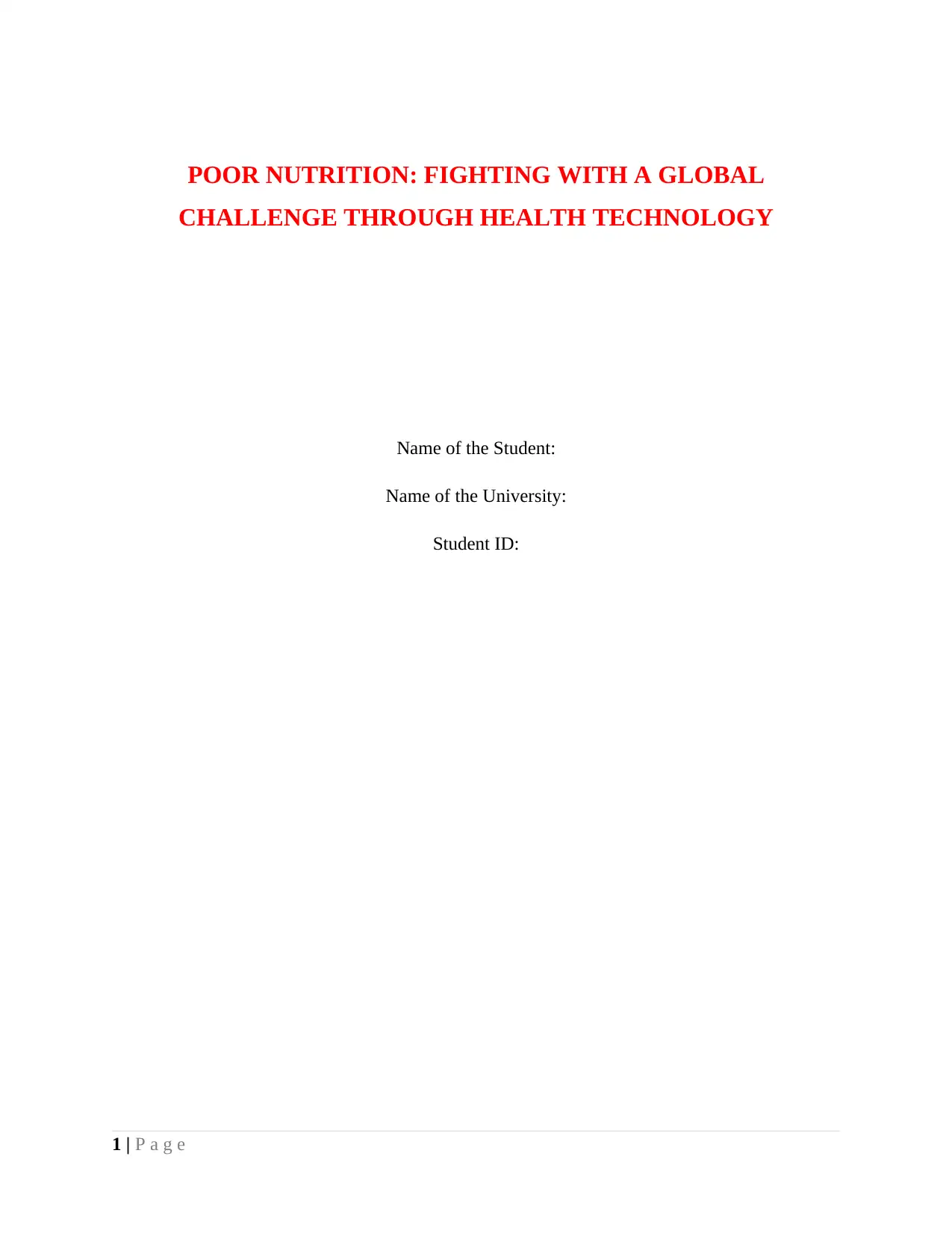
POOR NUTRITION: FIGHTING WITH A GLOBAL
CHALLENGE THROUGH HEALTH TECHNOLOGY
Name of the Student:
Name of the University:
Student ID:
1 | P a g e
CHALLENGE THROUGH HEALTH TECHNOLOGY
Name of the Student:
Name of the University:
Student ID:
1 | P a g e
Paraphrase This Document
Need a fresh take? Get an instant paraphrase of this document with our AI Paraphraser
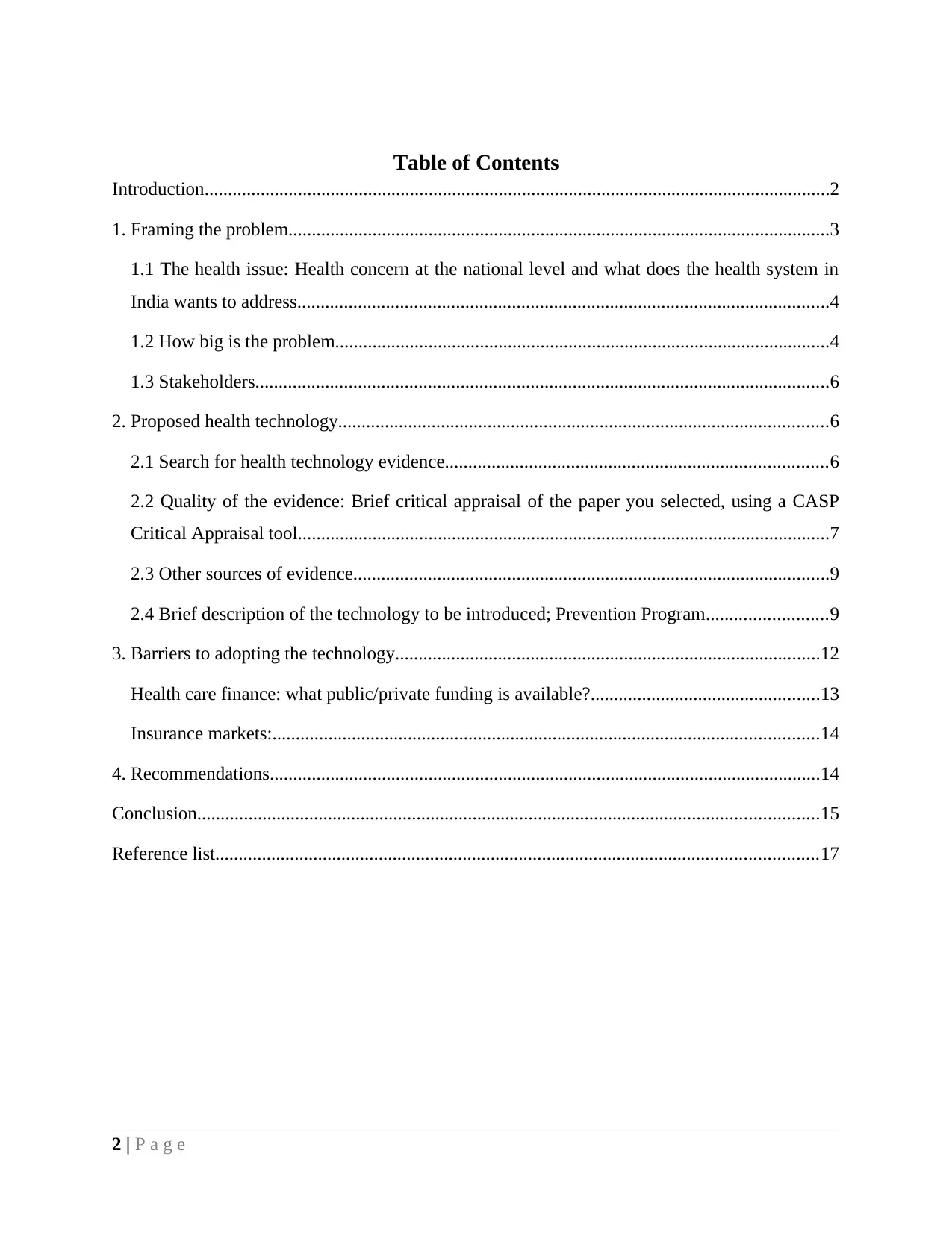
Table of Contents
Introduction......................................................................................................................................2
1. Framing the problem....................................................................................................................3
1.1 The health issue: Health concern at the national level and what does the health system in
India wants to address..................................................................................................................4
1.2 How big is the problem..........................................................................................................4
1.3 Stakeholders...........................................................................................................................6
2. Proposed health technology.........................................................................................................6
2.1 Search for health technology evidence..................................................................................6
2.2 Quality of the evidence: Brief critical appraisal of the paper you selected, using a CASP
Critical Appraisal tool..................................................................................................................7
2.3 Other sources of evidence......................................................................................................9
2.4 Brief description of the technology to be introduced; Prevention Program..........................9
3. Barriers to adopting the technology...........................................................................................12
Health care finance: what public/private funding is available?.................................................13
Insurance markets:.....................................................................................................................14
4. Recommendations......................................................................................................................14
Conclusion.....................................................................................................................................15
Reference list.................................................................................................................................17
2 | P a g e
Introduction......................................................................................................................................2
1. Framing the problem....................................................................................................................3
1.1 The health issue: Health concern at the national level and what does the health system in
India wants to address..................................................................................................................4
1.2 How big is the problem..........................................................................................................4
1.3 Stakeholders...........................................................................................................................6
2. Proposed health technology.........................................................................................................6
2.1 Search for health technology evidence..................................................................................6
2.2 Quality of the evidence: Brief critical appraisal of the paper you selected, using a CASP
Critical Appraisal tool..................................................................................................................7
2.3 Other sources of evidence......................................................................................................9
2.4 Brief description of the technology to be introduced; Prevention Program..........................9
3. Barriers to adopting the technology...........................................................................................12
Health care finance: what public/private funding is available?.................................................13
Insurance markets:.....................................................................................................................14
4. Recommendations......................................................................................................................14
Conclusion.....................................................................................................................................15
Reference list.................................................................................................................................17
2 | P a g e
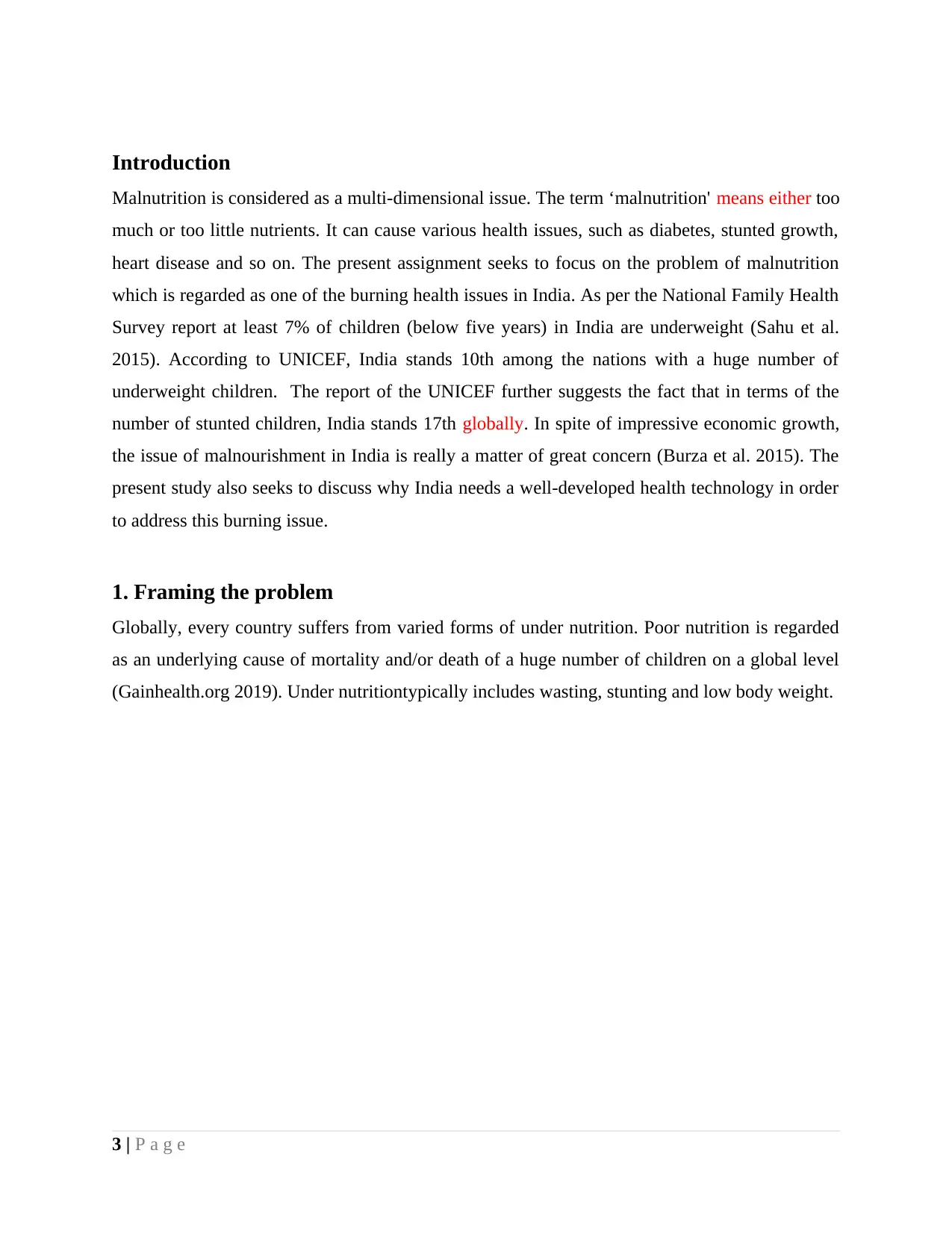
Introduction
Malnutrition is considered as a multi-dimensional issue. The term ‘malnutrition' means either too
much or too little nutrients. It can cause various health issues, such as diabetes, stunted growth,
heart disease and so on. The present assignment seeks to focus on the problem of malnutrition
which is regarded as one of the burning health issues in India. As per the National Family Health
Survey report at least 7% of children (below five years) in India are underweight (Sahu et al.
2015). According to UNICEF, India stands 10th among the nations with a huge number of
underweight children. The report of the UNICEF further suggests the fact that in terms of the
number of stunted children, India stands 17th globally. In spite of impressive economic growth,
the issue of malnourishment in India is really a matter of great concern (Burza et al. 2015). The
present study also seeks to discuss why India needs a well-developed health technology in order
to address this burning issue.
1. Framing the problem
Globally, every country suffers from varied forms of under nutrition. Poor nutrition is regarded
as an underlying cause of mortality and/or death of a huge number of children on a global level
(Gainhealth.org 2019). Under nutritiontypically includes wasting, stunting and low body weight.
3 | P a g e
Malnutrition is considered as a multi-dimensional issue. The term ‘malnutrition' means either too
much or too little nutrients. It can cause various health issues, such as diabetes, stunted growth,
heart disease and so on. The present assignment seeks to focus on the problem of malnutrition
which is regarded as one of the burning health issues in India. As per the National Family Health
Survey report at least 7% of children (below five years) in India are underweight (Sahu et al.
2015). According to UNICEF, India stands 10th among the nations with a huge number of
underweight children. The report of the UNICEF further suggests the fact that in terms of the
number of stunted children, India stands 17th globally. In spite of impressive economic growth,
the issue of malnourishment in India is really a matter of great concern (Burza et al. 2015). The
present study also seeks to discuss why India needs a well-developed health technology in order
to address this burning issue.
1. Framing the problem
Globally, every country suffers from varied forms of under nutrition. Poor nutrition is regarded
as an underlying cause of mortality and/or death of a huge number of children on a global level
(Gainhealth.org 2019). Under nutritiontypically includes wasting, stunting and low body weight.
3 | P a g e
⊘ This is a preview!⊘
Do you want full access?
Subscribe today to unlock all pages.

Trusted by 1+ million students worldwide
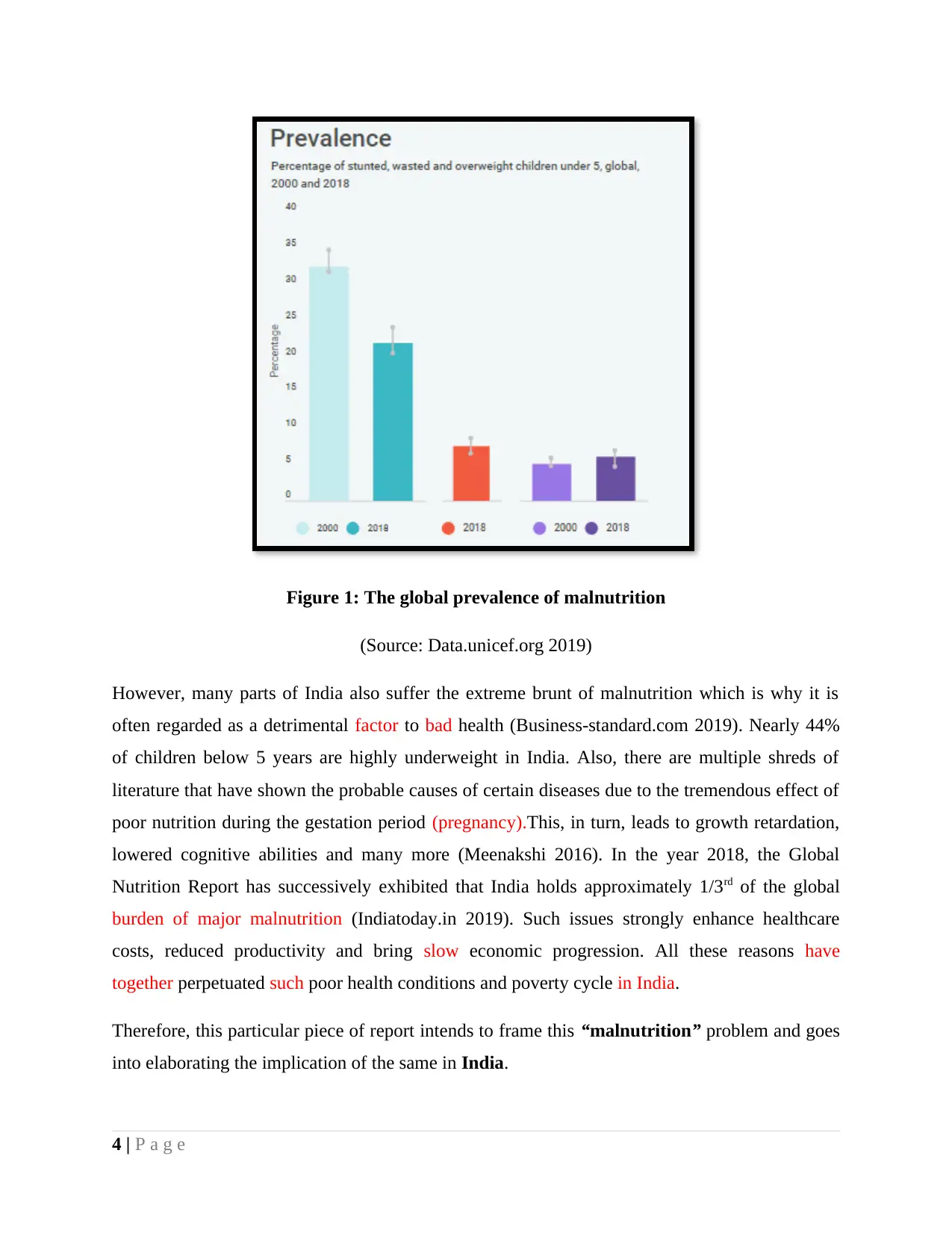
Figure 1: The global prevalence of malnutrition
(Source: Data.unicef.org 2019)
However, many parts of India also suffer the extreme brunt of malnutrition which is why it is
often regarded as a detrimental factor to bad health (Business-standard.com 2019). Nearly 44%
of children below 5 years are highly underweight in India. Also, there are multiple shreds of
literature that have shown the probable causes of certain diseases due to the tremendous effect of
poor nutrition during the gestation period (pregnancy).This, in turn, leads to growth retardation,
lowered cognitive abilities and many more (Meenakshi 2016). In the year 2018, the Global
Nutrition Report has successively exhibited that India holds approximately 1/3rd of the global
burden of major malnutrition (Indiatoday.in 2019). Such issues strongly enhance healthcare
costs, reduced productivity and bring slow economic progression. All these reasons have
together perpetuated such poor health conditions and poverty cycle in India.
Therefore, this particular piece of report intends to frame this “malnutrition” problem and goes
into elaborating the implication of the same in India.
4 | P a g e
(Source: Data.unicef.org 2019)
However, many parts of India also suffer the extreme brunt of malnutrition which is why it is
often regarded as a detrimental factor to bad health (Business-standard.com 2019). Nearly 44%
of children below 5 years are highly underweight in India. Also, there are multiple shreds of
literature that have shown the probable causes of certain diseases due to the tremendous effect of
poor nutrition during the gestation period (pregnancy).This, in turn, leads to growth retardation,
lowered cognitive abilities and many more (Meenakshi 2016). In the year 2018, the Global
Nutrition Report has successively exhibited that India holds approximately 1/3rd of the global
burden of major malnutrition (Indiatoday.in 2019). Such issues strongly enhance healthcare
costs, reduced productivity and bring slow economic progression. All these reasons have
together perpetuated such poor health conditions and poverty cycle in India.
Therefore, this particular piece of report intends to frame this “malnutrition” problem and goes
into elaborating the implication of the same in India.
4 | P a g e
Paraphrase This Document
Need a fresh take? Get an instant paraphrase of this document with our AI Paraphraser
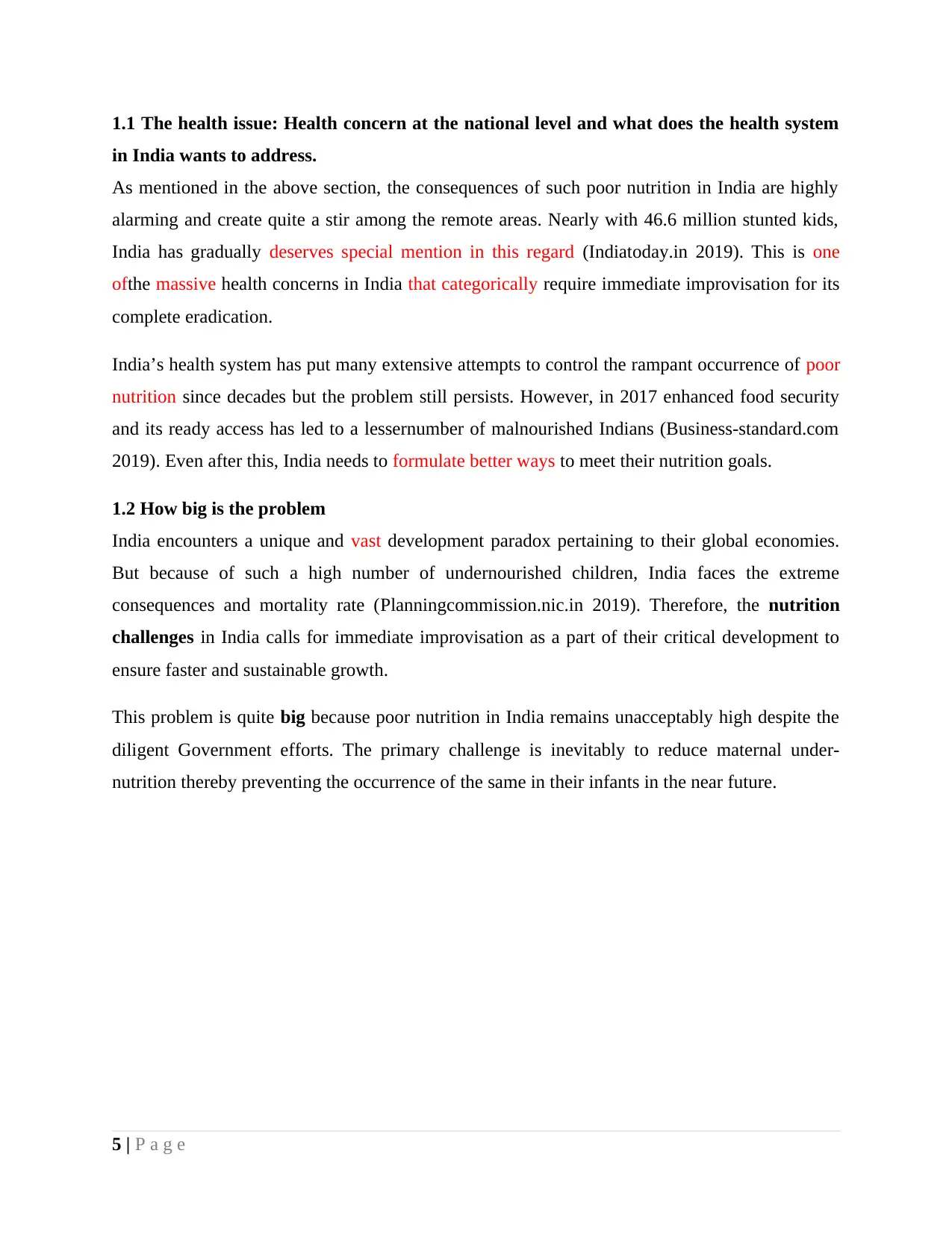
1.1 The health issue: Health concern at the national level and what does the health system
in India wants to address.
As mentioned in the above section, the consequences of such poor nutrition in India are highly
alarming and create quite a stir among the remote areas. Nearly with 46.6 million stunted kids,
India has gradually deserves special mention in this regard (Indiatoday.in 2019). This is one
ofthe massive health concerns in India that categorically require immediate improvisation for its
complete eradication.
India’s health system has put many extensive attempts to control the rampant occurrence of poor
nutrition since decades but the problem still persists. However, in 2017 enhanced food security
and its ready access has led to a lessernumber of malnourished Indians (Business-standard.com
2019). Even after this, India needs to formulate better ways to meet their nutrition goals.
1.2 How big is the problem
India encounters a unique and vast development paradox pertaining to their global economies.
But because of such a high number of undernourished children, India faces the extreme
consequences and mortality rate (Planningcommission.nic.in 2019). Therefore, the nutrition
challenges in India calls for immediate improvisation as a part of their critical development to
ensure faster and sustainable growth.
This problem is quite big because poor nutrition in India remains unacceptably high despite the
diligent Government efforts. The primary challenge is inevitably to reduce maternal under-
nutrition thereby preventing the occurrence of the same in their infants in the near future.
5 | P a g e
in India wants to address.
As mentioned in the above section, the consequences of such poor nutrition in India are highly
alarming and create quite a stir among the remote areas. Nearly with 46.6 million stunted kids,
India has gradually deserves special mention in this regard (Indiatoday.in 2019). This is one
ofthe massive health concerns in India that categorically require immediate improvisation for its
complete eradication.
India’s health system has put many extensive attempts to control the rampant occurrence of poor
nutrition since decades but the problem still persists. However, in 2017 enhanced food security
and its ready access has led to a lessernumber of malnourished Indians (Business-standard.com
2019). Even after this, India needs to formulate better ways to meet their nutrition goals.
1.2 How big is the problem
India encounters a unique and vast development paradox pertaining to their global economies.
But because of such a high number of undernourished children, India faces the extreme
consequences and mortality rate (Planningcommission.nic.in 2019). Therefore, the nutrition
challenges in India calls for immediate improvisation as a part of their critical development to
ensure faster and sustainable growth.
This problem is quite big because poor nutrition in India remains unacceptably high despite the
diligent Government efforts. The primary challenge is inevitably to reduce maternal under-
nutrition thereby preventing the occurrence of the same in their infants in the near future.
5 | P a g e
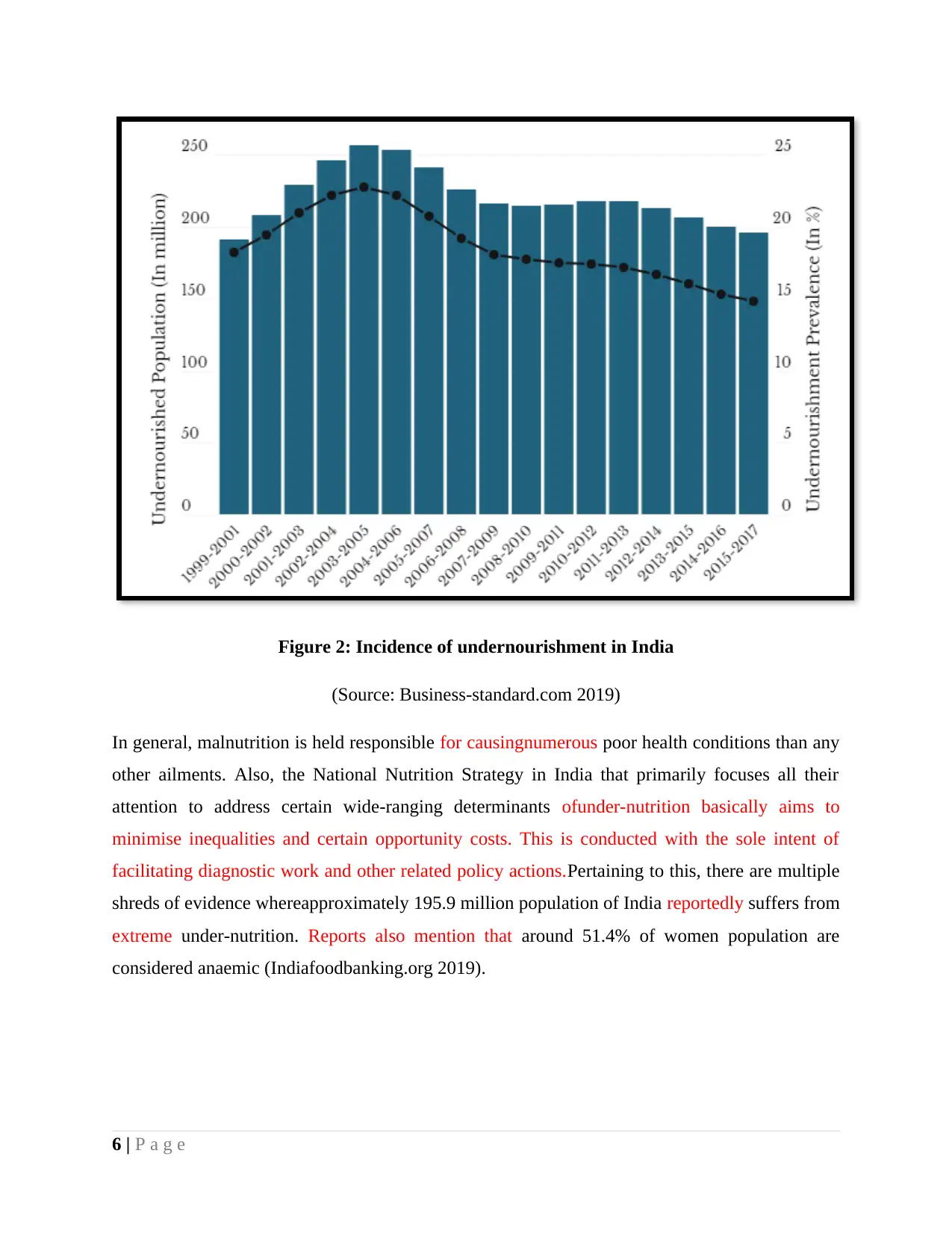
Figure 2: Incidence of undernourishment in India
(Source: Business-standard.com 2019)
In general, malnutrition is held responsible for causingnumerous poor health conditions than any
other ailments. Also, the National Nutrition Strategy in India that primarily focuses all their
attention to address certain wide-ranging determinants ofunder-nutrition basically aims to
minimise inequalities and certain opportunity costs. This is conducted with the sole intent of
facilitating diagnostic work and other related policy actions.Pertaining to this, there are multiple
shreds of evidence whereapproximately 195.9 million population of India reportedly suffers from
extreme under-nutrition. Reports also mention that around 51.4% of women population are
considered anaemic (Indiafoodbanking.org 2019).
6 | P a g e
(Source: Business-standard.com 2019)
In general, malnutrition is held responsible for causingnumerous poor health conditions than any
other ailments. Also, the National Nutrition Strategy in India that primarily focuses all their
attention to address certain wide-ranging determinants ofunder-nutrition basically aims to
minimise inequalities and certain opportunity costs. This is conducted with the sole intent of
facilitating diagnostic work and other related policy actions.Pertaining to this, there are multiple
shreds of evidence whereapproximately 195.9 million population of India reportedly suffers from
extreme under-nutrition. Reports also mention that around 51.4% of women population are
considered anaemic (Indiafoodbanking.org 2019).
6 | P a g e
⊘ This is a preview!⊘
Do you want full access?
Subscribe today to unlock all pages.

Trusted by 1+ million students worldwide

Figure 3: Stunting rates of kids below 5 years in higher in India
(Source: Gainhealth.org 2019).
1.3 Stakeholders
In this regard, there are a wide-series of stakeholders associated with Indian malnutrition-
oriented problems. Because this has evidently become quite a common challenge, the list of
stakeholders is quite huge. The Indian Government, people belonging to below poverty line or
people with marginally low monthly income, the different health sectors including the wide-
ranging health professionals like the physicians, the nursing communities and also the varied
NGOs are all considered as the prospective stakeholders.
2. Proposed health technology
2.1 Search for health technology evidence
In order to find out suitable health technology evidence, I have searched in Google search
engine, Google Scholar, EBSCO, PubMed and so on. Although a number of hits appeared in the
results, only four of them were relevant. After going through each of the four pieces of evidence
minutely, I have finally chosen the paper named "The Use of Technology in Identifying
7 | P a g e
(Source: Gainhealth.org 2019).
1.3 Stakeholders
In this regard, there are a wide-series of stakeholders associated with Indian malnutrition-
oriented problems. Because this has evidently become quite a common challenge, the list of
stakeholders is quite huge. The Indian Government, people belonging to below poverty line or
people with marginally low monthly income, the different health sectors including the wide-
ranging health professionals like the physicians, the nursing communities and also the varied
NGOs are all considered as the prospective stakeholders.
2. Proposed health technology
2.1 Search for health technology evidence
In order to find out suitable health technology evidence, I have searched in Google search
engine, Google Scholar, EBSCO, PubMed and so on. Although a number of hits appeared in the
results, only four of them were relevant. After going through each of the four pieces of evidence
minutely, I have finally chosen the paper named "The Use of Technology in Identifying
7 | P a g e
Paraphrase This Document
Need a fresh take? Get an instant paraphrase of this document with our AI Paraphraser
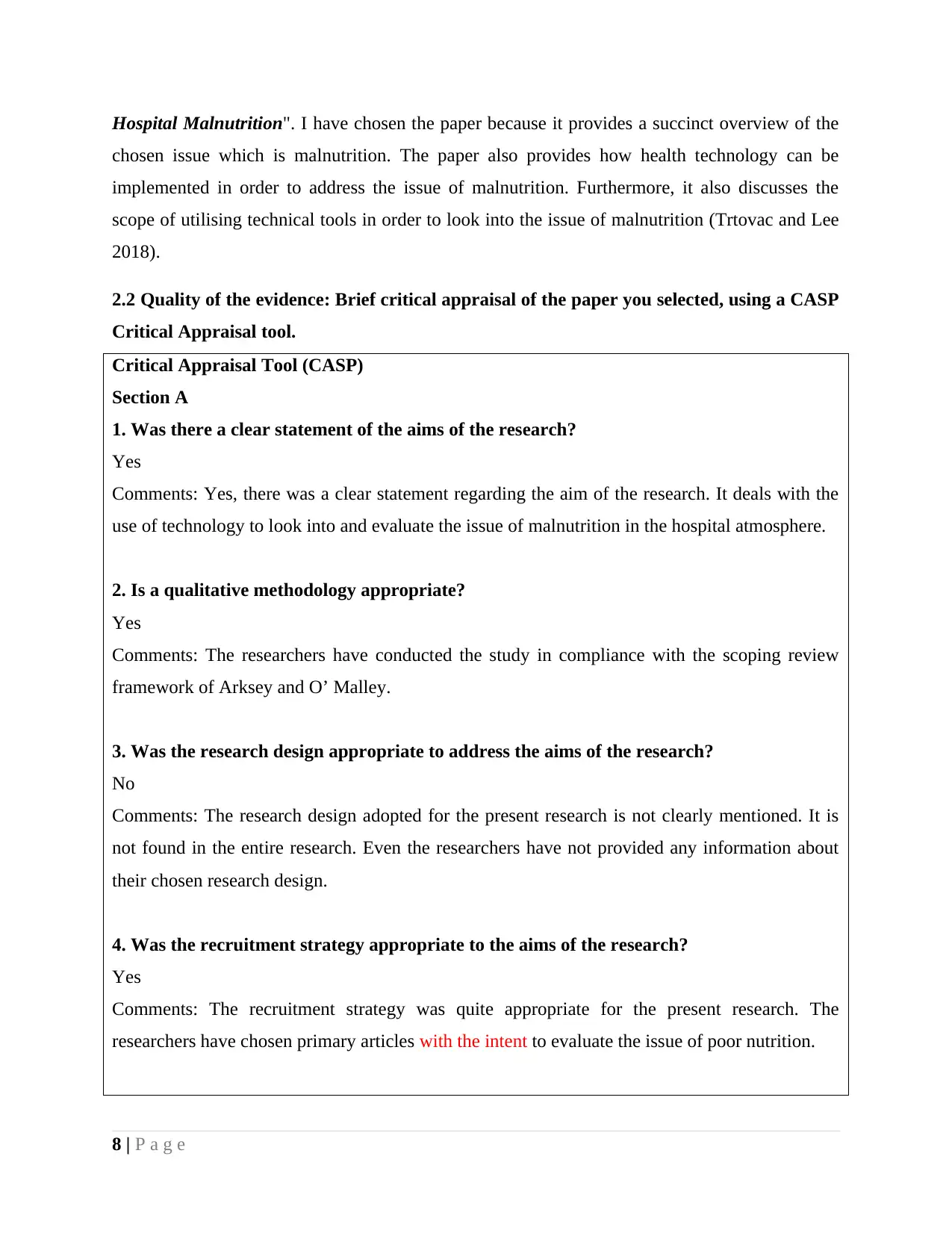
Hospital Malnutrition". I have chosen the paper because it provides a succinct overview of the
chosen issue which is malnutrition. The paper also provides how health technology can be
implemented in order to address the issue of malnutrition. Furthermore, it also discusses the
scope of utilising technical tools in order to look into the issue of malnutrition (Trtovac and Lee
2018).
2.2 Quality of the evidence: Brief critical appraisal of the paper you selected, using a CASP
Critical Appraisal tool.
Critical Appraisal Tool (CASP)
Section A
1. Was there a clear statement of the aims of the research?
Yes
Comments: Yes, there was a clear statement regarding the aim of the research. It deals with the
use of technology to look into and evaluate the issue of malnutrition in the hospital atmosphere.
2. Is a qualitative methodology appropriate?
Yes
Comments: The researchers have conducted the study in compliance with the scoping review
framework of Arksey and O’ Malley.
3. Was the research design appropriate to address the aims of the research?
No
Comments: The research design adopted for the present research is not clearly mentioned. It is
not found in the entire research. Even the researchers have not provided any information about
their chosen research design.
4. Was the recruitment strategy appropriate to the aims of the research?
Yes
Comments: The recruitment strategy was quite appropriate for the present research. The
researchers have chosen primary articles with the intent to evaluate the issue of poor nutrition.
8 | P a g e
chosen issue which is malnutrition. The paper also provides how health technology can be
implemented in order to address the issue of malnutrition. Furthermore, it also discusses the
scope of utilising technical tools in order to look into the issue of malnutrition (Trtovac and Lee
2018).
2.2 Quality of the evidence: Brief critical appraisal of the paper you selected, using a CASP
Critical Appraisal tool.
Critical Appraisal Tool (CASP)
Section A
1. Was there a clear statement of the aims of the research?
Yes
Comments: Yes, there was a clear statement regarding the aim of the research. It deals with the
use of technology to look into and evaluate the issue of malnutrition in the hospital atmosphere.
2. Is a qualitative methodology appropriate?
Yes
Comments: The researchers have conducted the study in compliance with the scoping review
framework of Arksey and O’ Malley.
3. Was the research design appropriate to address the aims of the research?
No
Comments: The research design adopted for the present research is not clearly mentioned. It is
not found in the entire research. Even the researchers have not provided any information about
their chosen research design.
4. Was the recruitment strategy appropriate to the aims of the research?
Yes
Comments: The recruitment strategy was quite appropriate for the present research. The
researchers have chosen primary articles with the intent to evaluate the issue of poor nutrition.
8 | P a g e
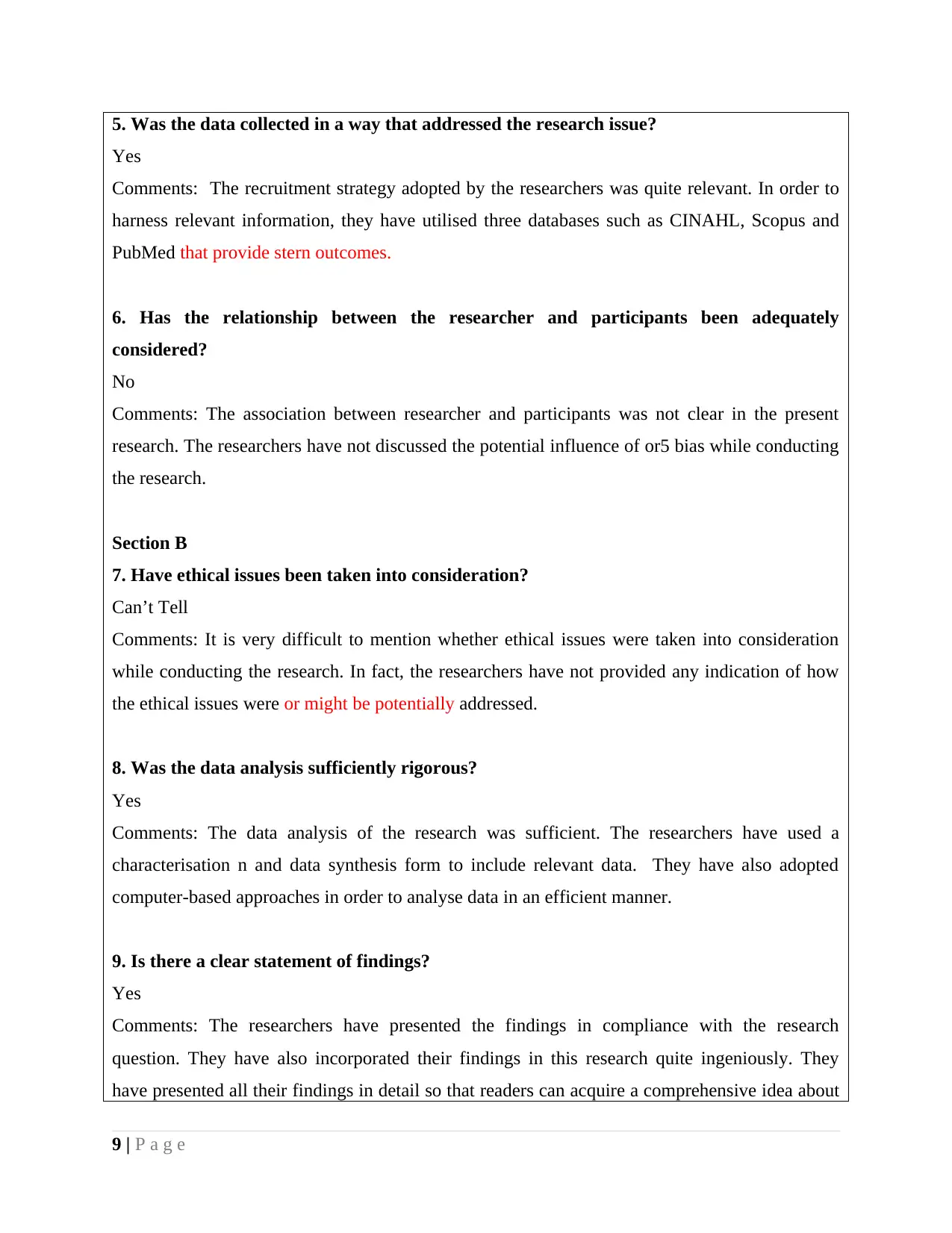
5. Was the data collected in a way that addressed the research issue?
Yes
Comments: The recruitment strategy adopted by the researchers was quite relevant. In order to
harness relevant information, they have utilised three databases such as CINAHL, Scopus and
PubMed that provide stern outcomes.
6. Has the relationship between the researcher and participants been adequately
considered?
No
Comments: The association between researcher and participants was not clear in the present
research. The researchers have not discussed the potential influence of or5 bias while conducting
the research.
Section B
7. Have ethical issues been taken into consideration?
Can’t Tell
Comments: It is very difficult to mention whether ethical issues were taken into consideration
while conducting the research. In fact, the researchers have not provided any indication of how
the ethical issues were or might be potentially addressed.
8. Was the data analysis sufficiently rigorous?
Yes
Comments: The data analysis of the research was sufficient. The researchers have used a
characterisation n and data synthesis form to include relevant data. They have also adopted
computer-based approaches in order to analyse data in an efficient manner.
9. Is there a clear statement of findings?
Yes
Comments: The researchers have presented the findings in compliance with the research
question. They have also incorporated their findings in this research quite ingeniously. They
have presented all their findings in detail so that readers can acquire a comprehensive idea about
9 | P a g e
Yes
Comments: The recruitment strategy adopted by the researchers was quite relevant. In order to
harness relevant information, they have utilised three databases such as CINAHL, Scopus and
PubMed that provide stern outcomes.
6. Has the relationship between the researcher and participants been adequately
considered?
No
Comments: The association between researcher and participants was not clear in the present
research. The researchers have not discussed the potential influence of or5 bias while conducting
the research.
Section B
7. Have ethical issues been taken into consideration?
Can’t Tell
Comments: It is very difficult to mention whether ethical issues were taken into consideration
while conducting the research. In fact, the researchers have not provided any indication of how
the ethical issues were or might be potentially addressed.
8. Was the data analysis sufficiently rigorous?
Yes
Comments: The data analysis of the research was sufficient. The researchers have used a
characterisation n and data synthesis form to include relevant data. They have also adopted
computer-based approaches in order to analyse data in an efficient manner.
9. Is there a clear statement of findings?
Yes
Comments: The researchers have presented the findings in compliance with the research
question. They have also incorporated their findings in this research quite ingeniously. They
have presented all their findings in detail so that readers can acquire a comprehensive idea about
9 | P a g e
⊘ This is a preview!⊘
Do you want full access?
Subscribe today to unlock all pages.

Trusted by 1+ million students worldwide
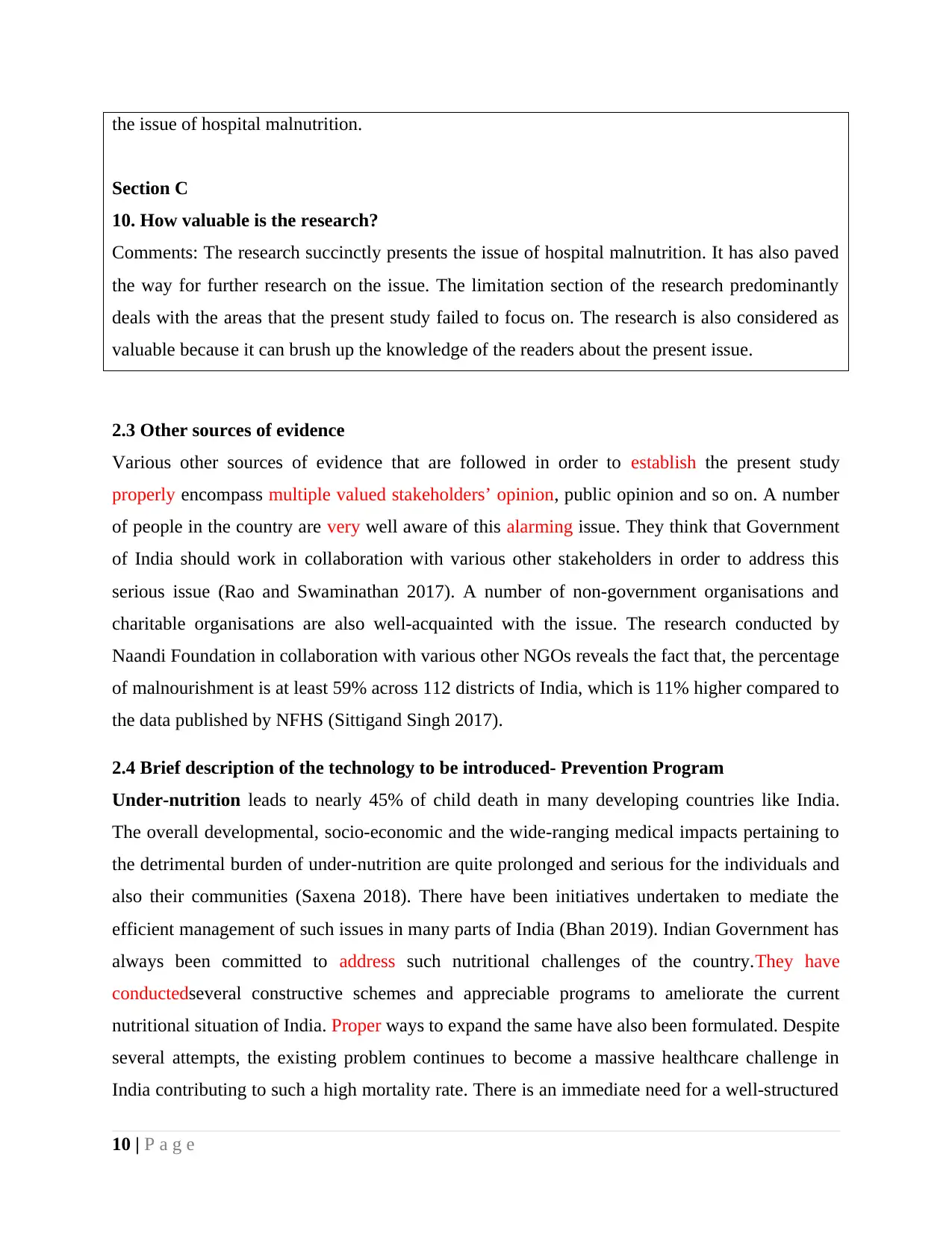
the issue of hospital malnutrition.
Section C
10. How valuable is the research?
Comments: The research succinctly presents the issue of hospital malnutrition. It has also paved
the way for further research on the issue. The limitation section of the research predominantly
deals with the areas that the present study failed to focus on. The research is also considered as
valuable because it can brush up the knowledge of the readers about the present issue.
2.3 Other sources of evidence
Various other sources of evidence that are followed in order to establish the present study
properly encompass multiple valued stakeholders’ opinion, public opinion and so on. A number
of people in the country are very well aware of this alarming issue. They think that Government
of India should work in collaboration with various other stakeholders in order to address this
serious issue (Rao and Swaminathan 2017). A number of non-government organisations and
charitable organisations are also well-acquainted with the issue. The research conducted by
Naandi Foundation in collaboration with various other NGOs reveals the fact that, the percentage
of malnourishment is at least 59% across 112 districts of India, which is 11% higher compared to
the data published by NFHS (Sittigand Singh 2017).
2.4 Brief description of the technology to be introduced- Prevention Program
Under-nutrition leads to nearly 45% of child death in many developing countries like India.
The overall developmental, socio-economic and the wide-ranging medical impacts pertaining to
the detrimental burden of under-nutrition are quite prolonged and serious for the individuals and
also their communities (Saxena 2018). There have been initiatives undertaken to mediate the
efficient management of such issues in many parts of India (Bhan 2019). Indian Government has
always been committed to address such nutritional challenges of the country.They have
conductedseveral constructive schemes and appreciable programs to ameliorate the current
nutritional situation of India. Proper ways to expand the same have also been formulated. Despite
several attempts, the existing problem continues to become a massive healthcare challenge in
India contributing to such a high mortality rate. There is an immediate need for a well-structured
10 | P a g e
Section C
10. How valuable is the research?
Comments: The research succinctly presents the issue of hospital malnutrition. It has also paved
the way for further research on the issue. The limitation section of the research predominantly
deals with the areas that the present study failed to focus on. The research is also considered as
valuable because it can brush up the knowledge of the readers about the present issue.
2.3 Other sources of evidence
Various other sources of evidence that are followed in order to establish the present study
properly encompass multiple valued stakeholders’ opinion, public opinion and so on. A number
of people in the country are very well aware of this alarming issue. They think that Government
of India should work in collaboration with various other stakeholders in order to address this
serious issue (Rao and Swaminathan 2017). A number of non-government organisations and
charitable organisations are also well-acquainted with the issue. The research conducted by
Naandi Foundation in collaboration with various other NGOs reveals the fact that, the percentage
of malnourishment is at least 59% across 112 districts of India, which is 11% higher compared to
the data published by NFHS (Sittigand Singh 2017).
2.4 Brief description of the technology to be introduced- Prevention Program
Under-nutrition leads to nearly 45% of child death in many developing countries like India.
The overall developmental, socio-economic and the wide-ranging medical impacts pertaining to
the detrimental burden of under-nutrition are quite prolonged and serious for the individuals and
also their communities (Saxena 2018). There have been initiatives undertaken to mediate the
efficient management of such issues in many parts of India (Bhan 2019). Indian Government has
always been committed to address such nutritional challenges of the country.They have
conductedseveral constructive schemes and appreciable programs to ameliorate the current
nutritional situation of India. Proper ways to expand the same have also been formulated. Despite
several attempts, the existing problem continues to become a massive healthcare challenge in
India contributing to such a high mortality rate. There is an immediate need for a well-structured
10 | P a g e
Paraphrase This Document
Need a fresh take? Get an instant paraphrase of this document with our AI Paraphraser
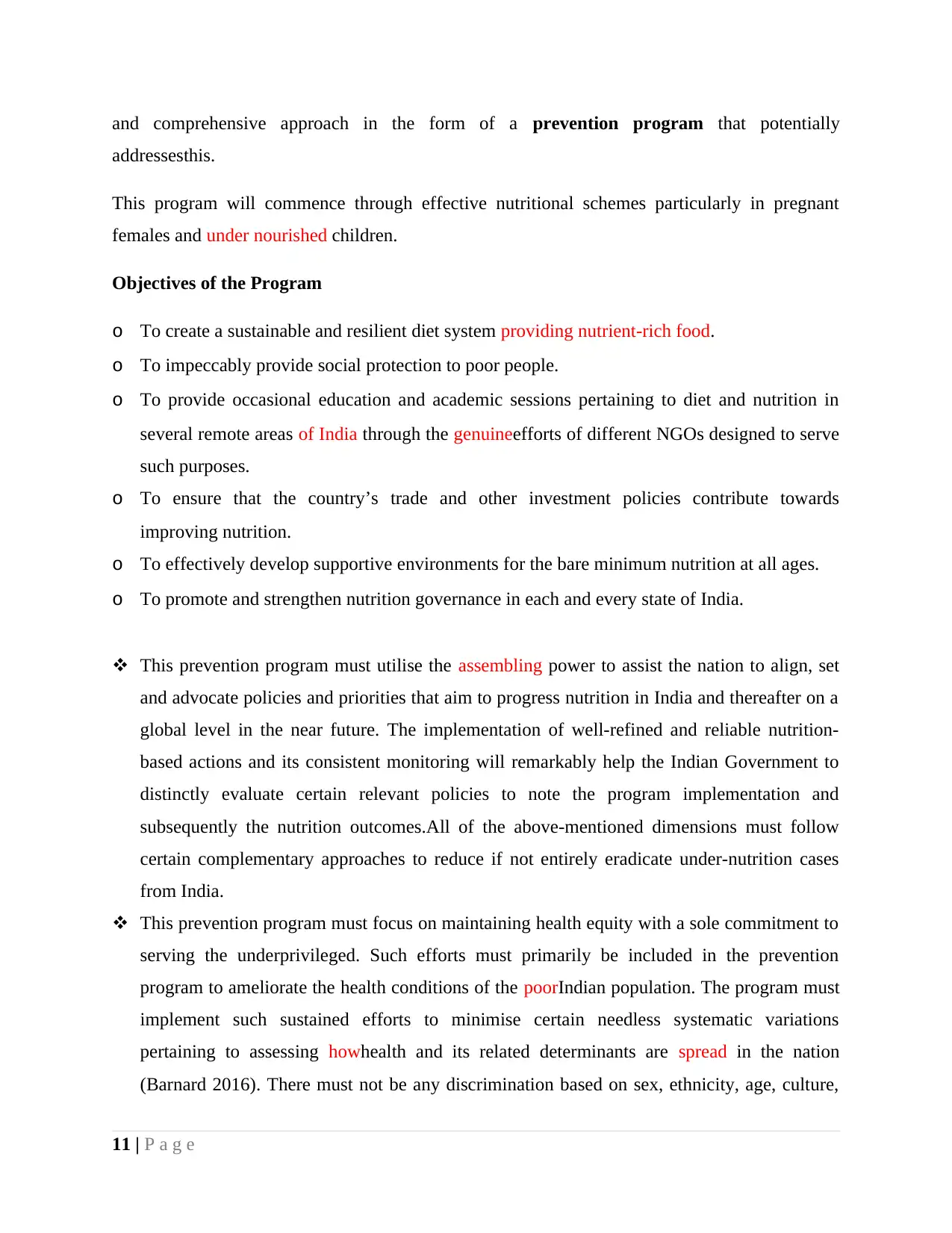
and comprehensive approach in the form of a prevention program that potentially
addressesthis.
This program will commence through effective nutritional schemes particularly in pregnant
females and under nourished children.
Objectives of the Program
o To create a sustainable and resilient diet system providing nutrient-rich food.
o To impeccably provide social protection to poor people.
o To provide occasional education and academic sessions pertaining to diet and nutrition in
several remote areas of India through the genuineefforts of different NGOs designed to serve
such purposes.
o To ensure that the country’s trade and other investment policies contribute towards
improving nutrition.
o To effectively develop supportive environments for the bare minimum nutrition at all ages.
o To promote and strengthen nutrition governance in each and every state of India.
This prevention program must utilise the assembling power to assist the nation to align, set
and advocate policies and priorities that aim to progress nutrition in India and thereafter on a
global level in the near future. The implementation of well-refined and reliable nutrition-
based actions and its consistent monitoring will remarkably help the Indian Government to
distinctly evaluate certain relevant policies to note the program implementation and
subsequently the nutrition outcomes.All of the above-mentioned dimensions must follow
certain complementary approaches to reduce if not entirely eradicate under-nutrition cases
from India.
This prevention program must focus on maintaining health equity with a sole commitment to
serving the underprivileged. Such efforts must primarily be included in the prevention
program to ameliorate the health conditions of the poorIndian population. The program must
implement such sustained efforts to minimise certain needless systematic variations
pertaining to assessing howhealth and its related determinants are spread in the nation
(Barnard 2016). There must not be any discrimination based on sex, ethnicity, age, culture,
11 | P a g e
addressesthis.
This program will commence through effective nutritional schemes particularly in pregnant
females and under nourished children.
Objectives of the Program
o To create a sustainable and resilient diet system providing nutrient-rich food.
o To impeccably provide social protection to poor people.
o To provide occasional education and academic sessions pertaining to diet and nutrition in
several remote areas of India through the genuineefforts of different NGOs designed to serve
such purposes.
o To ensure that the country’s trade and other investment policies contribute towards
improving nutrition.
o To effectively develop supportive environments for the bare minimum nutrition at all ages.
o To promote and strengthen nutrition governance in each and every state of India.
This prevention program must utilise the assembling power to assist the nation to align, set
and advocate policies and priorities that aim to progress nutrition in India and thereafter on a
global level in the near future. The implementation of well-refined and reliable nutrition-
based actions and its consistent monitoring will remarkably help the Indian Government to
distinctly evaluate certain relevant policies to note the program implementation and
subsequently the nutrition outcomes.All of the above-mentioned dimensions must follow
certain complementary approaches to reduce if not entirely eradicate under-nutrition cases
from India.
This prevention program must focus on maintaining health equity with a sole commitment to
serving the underprivileged. Such efforts must primarily be included in the prevention
program to ameliorate the health conditions of the poorIndian population. The program must
implement such sustained efforts to minimise certain needless systematic variations
pertaining to assessing howhealth and its related determinants are spread in the nation
(Barnard 2016). There must not be any discrimination based on sex, ethnicity, age, culture,
11 | P a g e
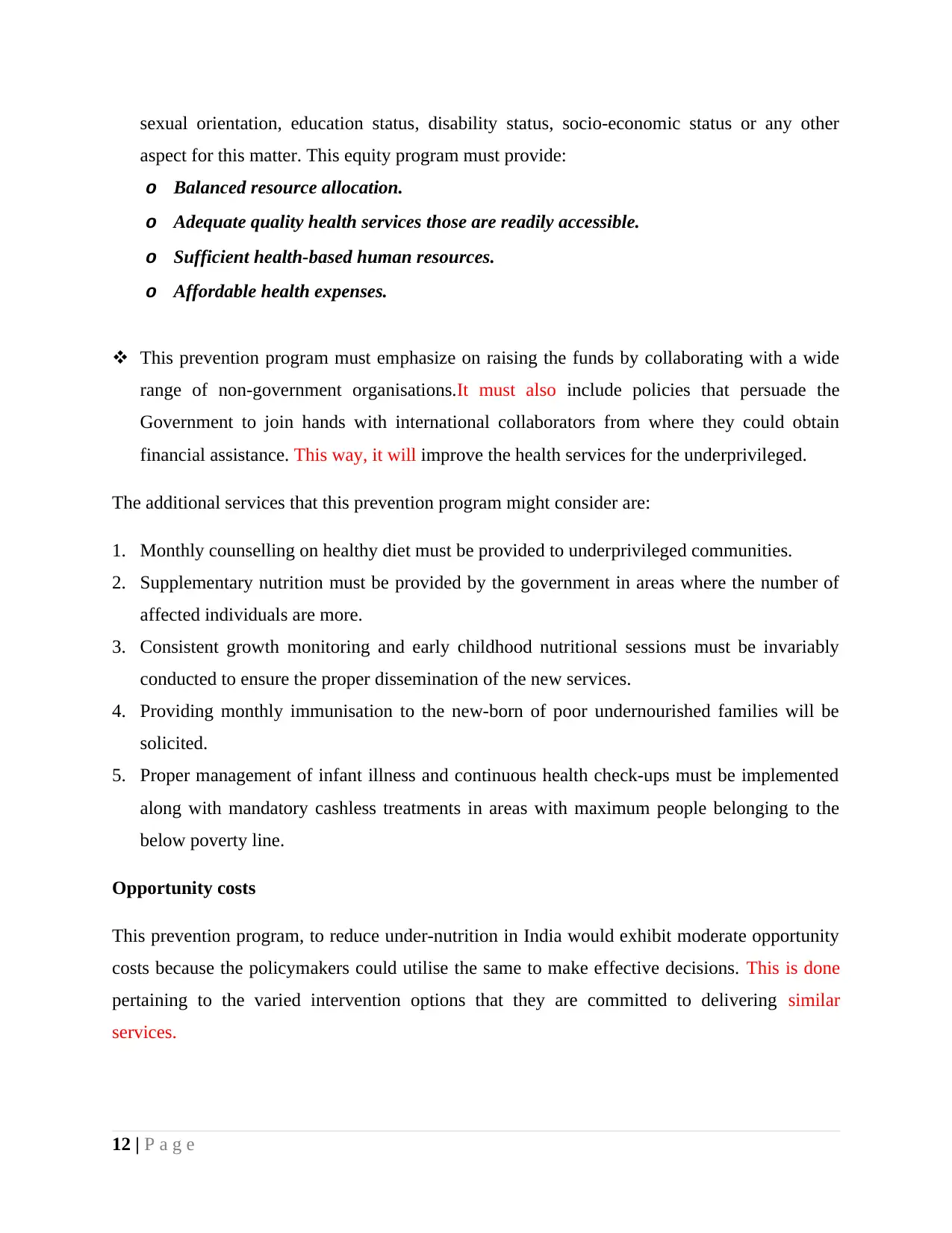
sexual orientation, education status, disability status, socio-economic status or any other
aspect for this matter. This equity program must provide:
o Balanced resource allocation.
o Adequate quality health services those are readily accessible.
o Sufficient health-based human resources.
o Affordable health expenses.
This prevention program must emphasize on raising the funds by collaborating with a wide
range of non-government organisations.It must also include policies that persuade the
Government to join hands with international collaborators from where they could obtain
financial assistance. This way, it will improve the health services for the underprivileged.
The additional services that this prevention program might consider are:
1. Monthly counselling on healthy diet must be provided to underprivileged communities.
2. Supplementary nutrition must be provided by the government in areas where the number of
affected individuals are more.
3. Consistent growth monitoring and early childhood nutritional sessions must be invariably
conducted to ensure the proper dissemination of the new services.
4. Providing monthly immunisation to the new-born of poor undernourished families will be
solicited.
5. Proper management of infant illness and continuous health check-ups must be implemented
along with mandatory cashless treatments in areas with maximum people belonging to the
below poverty line.
Opportunity costs
This prevention program, to reduce under-nutrition in India would exhibit moderate opportunity
costs because the policymakers could utilise the same to make effective decisions. This is done
pertaining to the varied intervention options that they are committed to delivering similar
services.
12 | P a g e
aspect for this matter. This equity program must provide:
o Balanced resource allocation.
o Adequate quality health services those are readily accessible.
o Sufficient health-based human resources.
o Affordable health expenses.
This prevention program must emphasize on raising the funds by collaborating with a wide
range of non-government organisations.It must also include policies that persuade the
Government to join hands with international collaborators from where they could obtain
financial assistance. This way, it will improve the health services for the underprivileged.
The additional services that this prevention program might consider are:
1. Monthly counselling on healthy diet must be provided to underprivileged communities.
2. Supplementary nutrition must be provided by the government in areas where the number of
affected individuals are more.
3. Consistent growth monitoring and early childhood nutritional sessions must be invariably
conducted to ensure the proper dissemination of the new services.
4. Providing monthly immunisation to the new-born of poor undernourished families will be
solicited.
5. Proper management of infant illness and continuous health check-ups must be implemented
along with mandatory cashless treatments in areas with maximum people belonging to the
below poverty line.
Opportunity costs
This prevention program, to reduce under-nutrition in India would exhibit moderate opportunity
costs because the policymakers could utilise the same to make effective decisions. This is done
pertaining to the varied intervention options that they are committed to delivering similar
services.
12 | P a g e
⊘ This is a preview!⊘
Do you want full access?
Subscribe today to unlock all pages.

Trusted by 1+ million students worldwide
1 out of 19
Related Documents
Your All-in-One AI-Powered Toolkit for Academic Success.
+13062052269
info@desklib.com
Available 24*7 on WhatsApp / Email
![[object Object]](/_next/static/media/star-bottom.7253800d.svg)
Unlock your academic potential
Copyright © 2020–2025 A2Z Services. All Rights Reserved. Developed and managed by ZUCOL.




